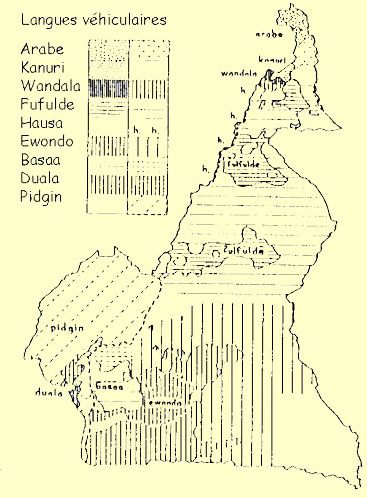
| Sociolingüística internacional |
| Plurilingual competence. A concrete example: Cameroon, by Mònica Molina | ||||
| CONTINUA |
The use of this teaching method results in an unnatural language lacking in register that native speakers often find strange. On the other hand, it clearly reveals the pompous use of languages perpetuated by this method of teaching, which also occurs in the case of French and English. Cameroon can be divided into four large areas in which only 9 national languages act as languages of intercommunication between the different groups that live in the country. The ATLAC (Atlas Linguistique du Cameroun, 1983) calls these languages langues véhiculaires and describes them as languages of intercommunication only at regional or provincial level (9) [see map]. -North (Fulfulde,
Shua Arabic, Haussa, Kanuri, Wandala); ATLAC (Atlas linguistique du Camerun, 1983)
The use of these nine languages –and of all other languages considered national– is practically reduced in everyday life to domestic situations, where individuals can be certain that the interlocutor will understand what they themselves call their patois –a type of speech considered to be socially-inferior belonging to reduced, domestic and local situations. (10) Here, an example would be the scant use of these languages in the mass media; only certain radio stations, such as Radio Centre in Yaounde, broadcast programmes in native languages (Bulu, Eton or Ewondo), but neither the press nor the television make habitual use of them. The country’s wide variety of languages has determined a language policy favouring the generalised use of a foreign language (French or English) as the language of intercommunication, even in domestic situations. 2. 2. The official language as a language of intercommunication According to the results of a survey conducted during the 2000-2001 academic year, (11) on primary-school pupils, the percentage of use of national languages in domestic situations reached 83%, whilst the same survey at secondary level, on pupils aged just four years older, saw this percentage reduced to 38%. Some of the factors directly influencing this progressive renunciation of national languages include the rural exodus and subsequent increase in the number of families made up of members from different ethnic groups, who choose English or French as their domestic language. |
